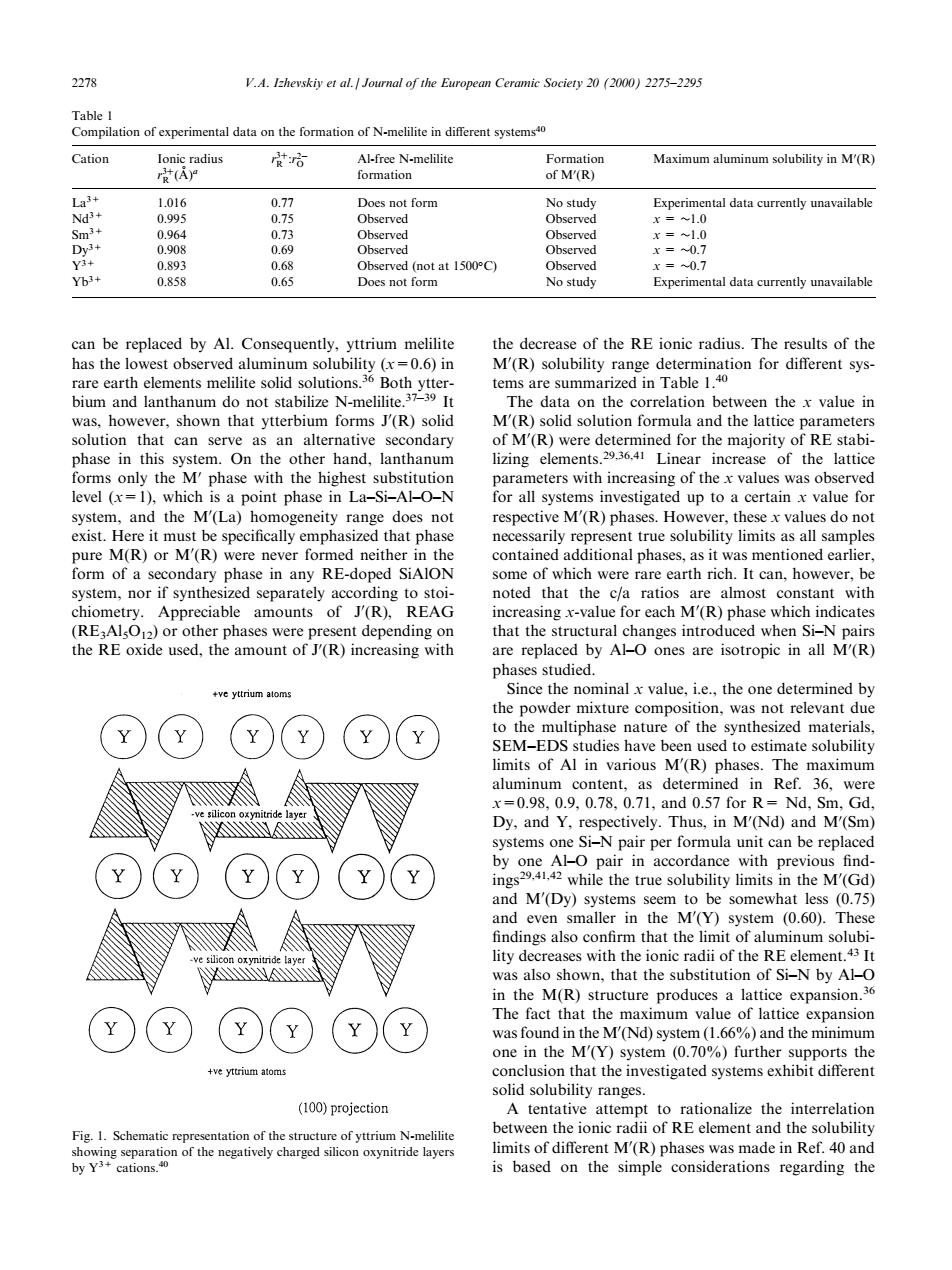正在加载图片...

2278 V.A.I-hevskiyet al Jourmal of the European Ceramic Society 20(2)2275-2295 Cation 哈 Maximum aluminum solubility in M'(R) 096 Docs not form No study 4 Exper ental data currently unavailable can be replaced by Al.Consequently,yttrium melilite the decrease of the RE ionic radius.The results of the has the lowest observed aluminum solubility (6)in areearheetmens are summa the x value in was.however.shown that ytterbium forms (R)solid M(R)solid solution formula and the lattice parameters solution that can serv as RE stabi phase the other hand i☑ng lement incre for all systems investigated up to a certain value fo system,and the M(La)homogeneity range does not respective M'(R)phases.However,thesex values do not ere nen a represen ed earlie noted that the c/a ratios are almost constant with amounts of J'(R),REAG ncreasing x-value nt depending reach M(R)phase which indicates that th reed when Since the nominal x value,i.e.,the one determined by ¥)(¥)(Y)(¥)(¥(Y limits of Al in various M'(R)phases.The maximum Dy. and v in M'(Nd)an systems one SiN pair per formula unit can be replaced hile the true solub bility limits in the M findings also confirm that the limit of aluminum solubi ses with the onic rad M(RY (Y)(Y(Y(Y system0./ solid solubility ranges (100)projection eionic rad cm.cm民can be replaced by Al. Consequently, yttrium melilite has the lowest observed aluminum solubility (x=0.6) in rare earth elements melilite solid solutions.36 Both ytterbium and lanthanum do not stabilize N-melilite.37ÿ39 It was, however, shown that ytterbium forms J0 (R) solid solution that can serve as an alternative secondary phase in this system. On the other hand, lanthanum forms only the M0 phase with the highest substitution level (x=1), which is a point phase in La±Si±Al±O±N system, and the M0 (La) homogeneity range does not exist. Here it must be speci®cally emphasized that phase pure M(R) or M0 (R) were never formed neither in the form of a secondary phase in any RE-doped SiAlON system, nor if synthesized separately according to stoichiometry. Appreciable amounts of J0 (R), REAG (RE3Al5O12) or other phases were present depending on the RE oxide used, the amount of J0 (R) increasing with the decrease of the RE ionic radius. The results of the M0 (R) solubility range determination for dierent systems are summarized in Table 1.40 The data on the correlation between the x value in M0 (R) solid solution formula and the lattice parameters of M0 (R) were determined for the majority of RE stabilizing elements.29,36,41 Linear increase of the lattice parameters with increasing of the x values was observed for all systems investigated up to a certain x value for respective M0 (R) phases. However, these x values do not necessarily represent true solubility limits as all samples contained additional phases, as it was mentioned earlier, some of which were rare earth rich. It can, however, be noted that the c/a ratios are almost constant with increasing x-value for each M0 (R) phase which indicates that the structural changes introduced when Si±N pairs are replaced by Al±O ones are isotropic in all M0 (R) phases studied. Since the nominal x value, i.e., the one determined by the powder mixture composition, was not relevant due to the multiphase nature of the synthesized materials, SEM±EDS studies have been used to estimate solubility limits of Al in various M0 (R) phases. The maximum aluminum content, as determined in Ref. 36, were x=0.98, 0.9, 0.78, 0.71, and 0.57 for R= Nd, Sm, Gd, Dy, and Y, respectively. Thus, in M0 (Nd) and M0 (Sm) systems one Si±N pair per formula unit can be replaced by one Al±O pair in accordance with previous ®ndings29,41,42 while the true solubility limits in the M0 (Gd) and M0 (Dy) systems seem to be somewhat less (0.75) and even smaller in the M0 (Y) system (0.60). These ®ndings also con®rm that the limit of aluminum solubility decreases with the ionic radii of the RE element.43 It was also shown, that the substitution of Si±N by Al±O in the M(R) structure produces a lattice expansion.36 The fact that the maximum value of lattice expansion was found in the M0 (Nd) system (1.66%) and the minimum one in the M0 (Y) system (0.70%) further supports the conclusion that the investigated systems exhibit dierent solid solubility ranges. A tentative attempt to rationalize the interrelation between the ionic radii of RE element and the solubility limits of dierent M0 (R) phases was made in Ref. 40 and is based on the simple considerations regarding the Table 1 Compilation of experimental data on the formation of N-melilite in dierent systems40 Cation Ionic radius r 3 R
A a r 3 R :r2ÿ O Al-free N-melilite formation Formation of M0 (R) Maximum aluminum solubility in M0 (R) La3+ 1.016 0.77 Does not form No study Experimental data currently unavailable Nd3+ 0.995 0.75 Observed Observed x = 1.0 Sm3+ 0.964 0.73 Observed Observed x = 1.0 Dy3+ 0.908 0.69 Observed Observed x = 0.7 Y3+ 0.893 0.68 Observed (not at 1500C) Observed x = 0.7 Yb3+ 0.858 0.65 Does not form No study Experimental data currently unavailable Fig. 1. Schematic representation of the structure of yttrium N-melilite showing separation of the negatively charged silicon oxynitride layers by Y3+ cations.40 2278 V.A. Izhevskiy et al. / Journal of the European Ceramic Society 20 (2000) 2275±2295